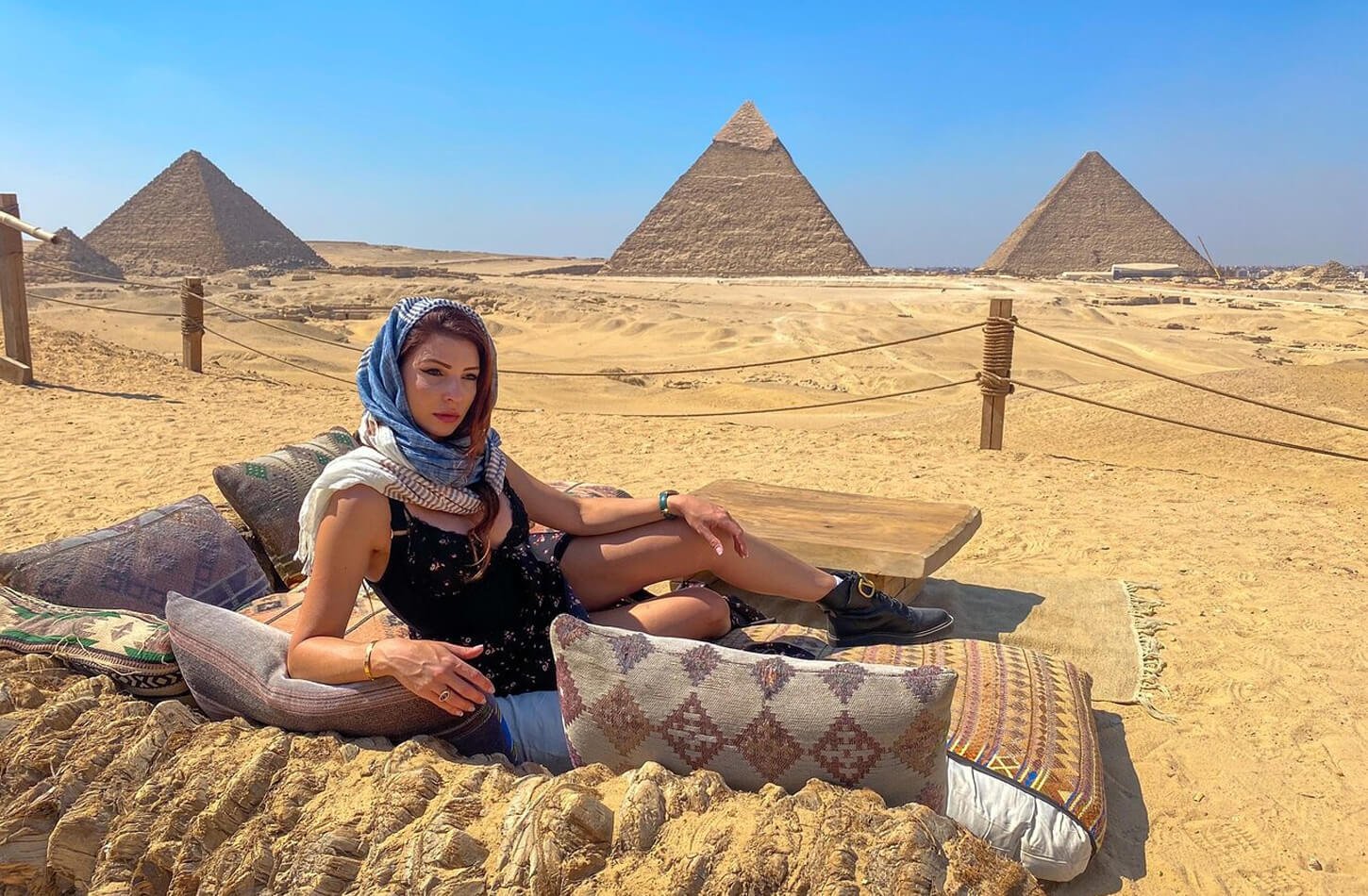Planning your trip to Egypt begins with knowing the best times to visit. October to April are the top months, with nice weather for exploring. In Cairo, the winter average of 66°F makes walking around fun.
Luxor’s 73°F in January is perfect for visiting ancient tombs. The West Bank Marathon in late January or February adds excitement to Luxor.
Choosing when to visit Egypt depends on what you like. Summer in Aswan can be very hot, with highs of 108°F. But, it’s quieter and you can find deals at Red Sea resorts like Sharm el-Sheikh or Hurghada.
Winter is busy and expensive, but spring and fall offer a good balance. April’s 95°F days are great for Nile trips. May has discounts for those on a budget. This guide will help you pick the best time for your trip to Egypt.
Understanding Egypt’s Climate Zones
Egypt’s climate changes a lot from one area to another. So, picking the optimal Egypt travel period depends on where you want to go. Each area has its own weather, making the Egypt travel season different.
The Mediterranean Coast Climate
Cities like Alexandria on the northern coast have mild winters. Daytime temperatures are around 64°F to 72°F. Rain is rare, with January getting about 49mm.

Summers are cooler than inland areas, reaching up to 88°F. Late fall or early spring is the best time to visit the coast.
Nile Valley and Cairo Weather Patterns
- Winter (Dec-Feb): Daytime temperatures are in the 60s-70s°F. It’s great for seeing Cairo’s pyramids and Giza without too much heat.
- Summer (Jun-Aug): Cairo gets very hot, over 95°F. The West Bank Marathon happens in cooler months.
- Rainfall: It’s rare, with Cairo’s wettest month (Dec) having only 4mm.
Desert Climate Considerations
In the Sahara and Western Desert, like the White Desert, summer days can be over 104°F. Nights can be 30°F cooler. March-May brings dusty winds, making it hard to take photos.
Bring layers for these big temperature changes.
Red Sea Coastal Conditions
Places like Sharm el-Sheikh and Hurghada are warm all year. Summer (Jun-Aug) is around 95°F, perfect for diving. Winter (Oct-Mar) has 80s°F days.
The Red Sea is great for water activities, making it a top choice for travel.
The Best Months to Visit Egypt for Perfect Weather
Wondering when to visit Egypt? October to April is the best time. It has mild weather and lots of cultural events. You can easily explore places like the Pyramids of Giza and Luxor’s temples.
- October to November: Enjoy daytime highs of 80°F. The Red Sea’s warm waters are perfect for swimming. You can also see the Abu Simbel Sun Festival in October. Cairo’s Nile River cruises are great during these months.
- December to February: Experience cool days (65–75°F) for desert safaris and walks in Aswan. There are more people around Christmas, but you’ll see festive markets and local traditions.
- March to April: The weather is warm (75–85°F) with fewer tourists. It’s a great time for hiking in Sinai or exploring Siwa Oasis in the Western Desert.
Avoid visiting in June to August because it’s very hot (often over 100°F). September and October are also good, with 80°F days and deals at places like Sharm El-Sheikh. Remember to bring layers for the desert evenings and waterproof gear for the Red Sea.
Peak Tourist Season: Pros and Cons
From December to February, Egypt’s peak tourist season is in full swing. This time is perfect for sightseeing because the weather is just right. But, you’ll face big crowds and higher prices. Here’s how to enjoy it despite these challenges.
November to February Crowds
Big sites like the Pyramids of Giza and Luxor’s Valley of the Kings get very busy. The Egyptian Museum in Cairo can have long lines during holidays. To avoid the crowds, take photos at sunrise.
Holiday Season Considerations
Christmas and New Year are the busiest times in Egypt. Events like the Cairo International Book Fair and the Abu Simbel Sun Festival attract many. Hotel and Nile cruise prices go up, so book early.
Booking Strategies During Peak Times
Book your stay and tours 6-8 months ahead to save money. Visit less famous sites like Saqqara or Dahshur pyramids during the day. Arrive at attractions by 8 AM to skip the crowds and sun.
- Use early-bird discounts for Nile cruises offered 3-4 months before December-February.
- Avoid booking during school holidays in Europe (late December) for fewer crowds.
- Combine visits to Red Sea resorts with Cairo during peak season for balanced itineraries.
Shoulder Season: The Secret Sweet Spot
Planning your Egypt trip? September-October and March-May are the best times. You’ll find mild weather, fewer people, and save up to 30% on hotels and tours.
- Smaller Crowds, Bigger Savings: Skip the winter rush and save 15-30% on Nile cruises and desert trips. Luxor’s Karnak Temple is peaceful without the crowds.
- Perfect Timing for Culture: March has Sham El-Nessim, a 5,000-year-old kite-flying and fava bean feast. September’s cool evenings make Luxor’s shows unforgettable.
- Photographer’s Paradise: Aswan and Abu Simbel’s soft light in shoulder seasons is perfect for photos. You’ll get clear skies and temple silhouettes.
- Strategic Comfort: September’s warm days turn into October’s cool nights. It’s great for hiking or snorkeling in Marsa Alam’s reefs.
Be ready for khamsin winds in spring, which might change your plans. Pack layers for changing weather. Book flexible trips. Shoulder seasons offer unique experiences, away from the crowds.
Summer in Egypt: What to Expect
Summer in Egypt (May to September) is hot, but it’s also a time for deals. Places like Luxor and Aswan get very hot. Yet, summer is a good time to find cheaper prices and fewer tourists. Here’s how to make the most of your trip during Egypt’s hottest months.
Dealing with the Heat
To survive the summer heat, plan carefully:
- Drink lots of water and avoid the sun at its strongest.
- Wear light, loose clothes and protect your skin from the sun.
- Visit air-conditioned places like the Egyptian Museum in Cairo.
- Go on trips when it’s cooler, like in the morning or evening.
Summer Budget Benefits
Summer is Egypt’s low season, with many perks:
- Hotels, Nile cruises, and tours can be up to 50% off.
- Places like the Giza Pyramids and Abu Simbel are less crowded.
- Flights and places to stay are cheaper from May to mid-September.
Early Morning and Evening Adventures
Here’s how to enjoy the cooler parts of the day:
- See the sun rise over the Pyramids or Karnak Temple.
- Visit markets like Khan el-Khalili at dusk when it’s cooler.
- Take a dinner cruise on the Nile for a nice evening.
Coastal Retreats
Find cool spots by the sea:
- Alexandria’s Agiba Beach or El Montazah Gardens for a breeze.
- Red Sea resorts like El Gouna or Dahab for diving.
- Visit the White and Black Deserts for amazing views.
Month-by-Month Breakdown for Egypt Travel
Choosing the best months to visit Egypt means knowing each season’s vibe. This guide shows you the monthly conditions for planning your trip. From winter’s festive feel to summer’s beach fun, each season has its own magic.
Winter Months (December-February)
Winter brings mild temps and cultural events:
- December: Cairo’s highs are 68°F. Christmas and New Year’s bring crowds, but Nile cruises are peaceful. Nights get chilly.
- January: Cairo’s average is 64°F. Luxor’s temples are perfect, with fewer people than December. Coptic Christmas (Jan 7) brings local joy.
- February: Cairo’s 66°F is ideal for desert hikes. The Abu Simbel Sun Festival lights up the Nile Valley.
Spring Months (March-May)
Spring brings warmer weather and cultural events:
- March: Cairo’s 72°F is great for museums before it gets hot. It’s a good time to visit with fewer crowds.
- April: Cairo’s 79°F is perfect for diving in the Red Sea. Easter crowds may fill hotels, but khamsin winds are rare.
- May: Cairo’s 86°F starts Ramadan, changing dining. Luxor’s Karnak Temple Festival in May attracts visitors despite the heat.
Summer Months (June-August)
Summer is hot but budget-friendly:
- June: Cairo’s 91°F means fewer people and lower prices. Night desert safaris are a must.
- July: Cairo’s 95°F is hot, but Red Sea resorts are lively. Evening beach trips are cooler.
- August: Cairo’s 95°F is great for diving in the Red Sea. Luxor’s night markets are cooler and fun.
Fall Months (September-November)
Fall brings golden weather and fewer crowds:
- September: Cairo’s 91°F is perfect for exploring. Luxor’s Sound and Light Show is nightly.
- October: Cairo’s 82°F is ideal for Valley of the Kings tours. Alexandria’s beaches are quieter.
- November: Cairo’s 75°F is the last chance for Nile cruises. Cooler days are great for Aswan’s Nubian villages.
Plan your trip with Egypt’s seasons in mind. Whether you prefer winter’s warmth or summer’s savings, each month offers something special.
Regional Considerations: When to Visit Specific Egyptian Destinations
When planning your trip to Egypt, the top holiday months in Egypt vary by region. Use this guide to match your itinerary with local conditions:
- Mediterranean Coast (Alexandria): Seek summer (June–August) for sea breezes cooling coastal areas. Daytime highs stay around 29°C (84°F), perfect for beach days.
- Cairo & Giza: Opt for November–March for mild weather (15–25°C). These when to go to Egypt months reduce heat stress while exploring open-air sites like the Pyramids.
- Luxor & Aswan: Winter (November–February) offers ideal temple-hopping temperatures (20–28°C). Avoid midday heat by starting tours at dawn.
- Red Sea Resorts (Sharm el-Sheikh, Dahab): Year-round appeal, but summer (June–September) delivers crystal-clear waters (27°C) for diving. Winter (October–April) balances land comfort with warm sea temps.
- Western Desert Oases: Visit February–April or September–November. Summers exceed 40°C, making exploration unsafe due to extreme heat.
- Sinai Peninsula: Coastal areas mirror Red Sea trends, while St. Catherine’s Monastery is cooler in summer (25°C) at 1,680m elevation.
Check regional specifics to avoid overlapping extreme weather. For instance, Luxor’s Khamsin sandstorms hit March–April, so book tours outside this window. Pairing destinations? Aim for October–April to balance Nile cruises, desert trips, and coastal relaxation seamlessly.

Cultural Festivals and Events: Timing Your Visit
Visiting Egypt during its festivals can make your trip unforgettable. You can enjoy religious events, music, or historical shows. The top holiday months in Egypt are perfect for these experiences. But, shoulder seasons also offer special moments. Here’s how to plan your trip:
- Ramadan and Eid Celebrations: Ramadan nights are filled with iftar parties, but places open later. Eid al-Fitr and Eid al-Adha are in spring or fall. Dress modestly and follow local meal times.
- Abu Simbel Sun Festival: Twice a year, sunlight hits the temple of Ramses II. October’s event is great for the ideal time for Egypt vacation weather in the Red Sea.
- West Bank Marathon: In late January or early February, enjoy cooler weather. It’s a great time to see Luxor’s ancient sites.
- Cultural Highlights: The Cairo International Film Festival (Nov-Dec) and the International Festival for Drums and Traditional Arts (April) are must-sees. Book early for these top holiday months in Egypt events.
- Coptic Christmas: On January 7th, join vibrant church services and feasts. It’s a great addition to your ideal time for Egypt vacation plans.
Plan early for these festivals. Some, like Ramadan, need respect for local life. Others, like Abu Simbel, offer unique photo chances. Always check dates and book early, as top holiday months in Egypt are busy. This way, you’ll enjoy both culture and comfort.
Packing Tips for Different Egypt Travel Seasons
When you plan your packing list, think about the Egypt travel season. Here are some tips to help you stay comfortable during your trip:
- Winter (November–February): Wear layers! Pack light sweaters, long sleeves, and a warm jacket for cold nights. Even on sunny days, a scarf and gloves are good for desert winds.
- Summer (June–August): Choose breathable cotton or linen clothes. Bring a long-sleeved shirt to keep bugs away, sunscreen (it’s expensive there), and a wide-brimmed hat. Also, don’t forget moisture-wicking socks for hot days.
- Shoulder Seasons (March–May, September–October): Wear light layers. A light jacket is good for cooler nights, and lightweight clothes are okay for daytime heat.
Things you should always bring:
- Sunscreen (SPF 50+), sunglasses, and a reusable water bottle.
- Insect repellent (50% of travelers face mosquitoes in summer).
- Covered clothing for religious sites (knees and shoulders covered).
- Electrical adapter (2-prong outlets, European style).
Don’t forget these extras:
- Reusable toiletries (solid shampoo bars save space and are hard to find locally).
- Travel insurance for health and theft protection.
- A locking pouch for valuables and a money belt.
- Menstrual products (scarce in rural areas).
Avoid bringing: CBD products, drones, or controversial materials. Carry cash in larger bills—locals can’t exchange $1 notes for tips.
Be ready for weather extremes and cultural norms. A well-packed bag makes your trip comfortable, whether you’re hiking pyramids or relaxing on Red Sea beaches!
Conclusion: Planning Your Perfect Egyptian Adventure
Deciding when to visit Egypt depends on what you want. October to April has the best weather, with Cairo’s temperatures ranging from 50°F to 70°F. This is the peak tourist season.
December to February is busier but perfect for seeing Cairo’s pyramids or Luxor’s temples. For fewer people, try October-November or March-April. These months are nice and not too hot, and you can save money.
Summer (June–August) might be hot, with highs of 45°C. But, it’s cheaper, with hotels and tours offering big discounts. Coastal areas like Hurghada and Dahab are cooler, with sea breezes.
Summer also has festivals like the Egyptian Marathon. Always book hotels early, 3–6 months before, for holidays like Christmas or New Year.
Check festival dates, like the Ascension of Ramses II on February 22nd and October 22nd. Visit temples early or dive in the Red Sea at night to avoid the heat. With a $25 visa and a $1,600 weekly budget, Egypt’s wonders are waiting for you.
Whether you want winter warmth in Aswan or spring in Alexandria, Egypt has it all. Plan your trip well to enjoy history, culture, and comfort.
Read our Related Article:








